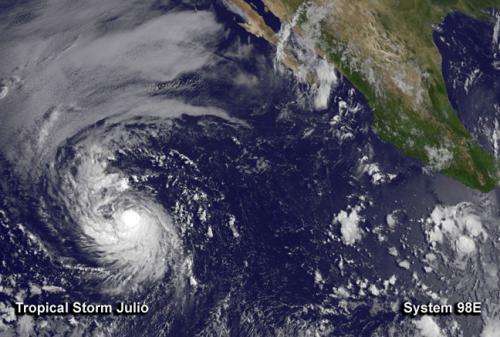NASA sees Tropical Storm Julio as part of a heated Eastern Pacific

The Eastern Pacific Ocean has been warm this springtime, and those warmer waters have contributed to the development of storms like Tropical Storm Julio and Hurricane Iselle.
"Ocean temperatures in the Eastern Tropical Pacific were heated up because of the strong Kelvin wave activity this spring. Although the initial excitement of an impending El Nino has quieted down, these warmer waters have caused an early and active hurricane season," said Bill Patzert, Climatologist at NASA's Jet Propulsion Laboratory in Pasadena, California.
"Kelvin waves" are massive ripples in sea level that travel across the Pacific from Australia to South America. Forecasters are paying close attention because these waves could be a herald of El Niño.
"Today, two strong cyclonic systems, Iselle (a major category 4 hurricane) and weaker Julio have their sights set on the Hawaiian Islands," Patzert said. "Hawaii is on high alert. Hurricane impacts in the Hawaiian Islands are quite unusual. Since 1950, only five hurricanes have made land-fall in the Islands. The good news is that both Iselle and Julio should weaken as they enter cooler ocean waters."
On August 5, NOAA's GOES-West satellite captured an image of Tropical Storm Julio and developing System 98E located near southern Mexico's coast.
On August 5 at 11 a.m. EDT (1500 UTC) Tropical Storm Julio had maximum sustained winds near 60 mph (95 kph). The National Hurricane Center (NHC) expects Julio to become a hurricane tomorrow, Wednesday, August 6.
Julio was centered about 1,145 miles (1,845 km) west-southwest of the southern tip of Baja California, near latitude 14.0 north and longitude 124.7 west. Julio is moving toward the west near 13 mph (20 kph). NHC expects a general westward to west-northwestward motion to continue through Thursday.
To the east of Tropical Storm Julio is yet another developing area of low pressure. That area, designated as System 98E is located near 10.3 north latitude and 98.1 west longitude several hundred miles south of Acapulco, Mexico. It has a medium chance of developing into a tropical depression in the next two days.
Provided by NASA's Goddard Space Flight Center





















